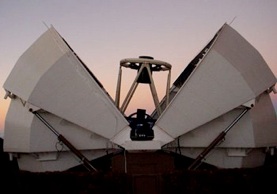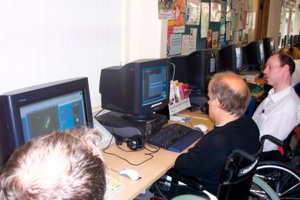Faulkes Telescope
Papworth to Hawaii and beyond
When David Roberts attended the FAS Conference at the Institute of Astronomy in Cambridge in Autumn 2005, he entered a prize draw with the little or no expectation of winning a prize. “I am not that lucky, and I thought that my stake money would go to a good cause, helping the FAS” recalls David. Imagine his shock when his ticket was first out of the hat, and he found that he’d won two hours observing time on the Faulkes Telescope!

Once the initial shock had worn off (which did take a little while) David registered his details with the Faulkes Operations Centre, and was advised to book the two hours over a few sessions, and to train on the simulator. “Rather than be totally selfish and keep the time to myself, I decided to share the prize with… Papworth Astronomy Club”.
As you can imagine, the Club was extremely grateful for David’s very generous gift! After a successful stint on the simulator, we booked our first “live” session for late January 2006, and further sessions were booked for March, April and May. However, these sessions were all cancelled due to a variety of reasons, including the Hawaiian weather and technical problems with the telescope.
Finally on June 3rd 2006, with the Hawaiian weather clear and all equipment functioning, we had our first successful observing session on the Faulkes Telescope North. Five image sets were obtained, and although one of M57 was spoiled by overexposure, there were good images of NGC7253A, PGC59061, NGC6621 and a field containing Pluto. It was agreed that for a first attempt, they were pretty good!

It was clear that observing with a professional system was not straightforward, and more care with sequencing our observations to minimise telescope slew time would make more efficient use of our valuable observing time. Also, more consideration about whether viewing more objects through a single colour filter, rather than making three-colour observations, would be a good idea.
Further sessions were again cancelled – first in the summer due to essential servicing works, and then again in the autumn because of an earthquake in Hawaii and a direct lightning strike to FTS in Australia. It was clear that patience is an important virtue when it comes to astronomy….
A second session eventually followed on July 24th, 2007 (yes, a year later!). Once again, telescope slew time was considerable, resulting in the half hour session yielding only 9 minutes of direct observing. However, we obtained good images of Arp319 (also known as Stephan’s Quintet), Abell 1151S (a rich cluster of galaxies), M76 (the Little Dumbell Nebula) and Arp112 (a group of interacting galaxies).
Our final session was once again delayed because of problems with the telescope, but this time only until September 6th. This was a far more productive session thanks to much better planning, and excellent images were obtained of PGC11491, PGC7415, PGC8961, NGC7662 (the Blue Snowball Nebula) and NGC7714.
Here are some of the images we captured during our observing sessions with the Faulkes Telescope.